Guangzhou, where old meets new
In an ever-changing urbanized landscape, many metropolises face a delicate balancing act in preserving the historical essence of neighborhoods while accommodating new developments. The Dongshankou and Yongqingfang districts in Guangdong's provincial capital are remarkable examples of old towns that have been revived, and where tradition and progress are intertwined. Liu Yifan reports from Guangzhou.
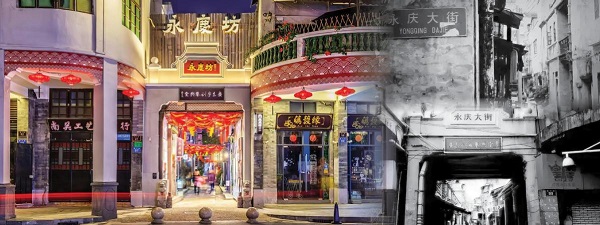
The retrofitted Yongqingfang (left) registers a striking contrast with its appearance in olden days (right). [Photo provided to chinadaily.com.cn]
Editor's note: February marks the fifth anniversary of the publication of the "Outline Development Plan for the Guangdong-Hong Kong-Macao Greater Bay Area". In the fifth part of China Daily's series on the most intriguing stories to come out of the Greater Bay Area cities within the past five years, we take an in-depth look at Guangzhou's endeavor to revitalize its old downtown neighborhoods and search for the business opportunities that have arisen in the process.
The revitalization of old towns has been a crucial but thorny issue for urban planners on the Chinese mainland in the past few decades since the nation's reform and opening-up. The redevelopment of downtown neighborhoods across the country is characterized by selling the properties involved to private developers who are given the freedom to transform them. This has led to overcommercialization and homogenization that ruins a city's cultural heritage and curtails its charisma.
But it's an offbeat story for Dongshankou - the largest Western-style building complex in Guangzhou, the provincial capital of Guangdong, as well as the cradle of China's democratic revolution and the vanguard of the country's opening-up to the world.
Dongshankou, which literally means "the entrance ofEast Hill", is a labyrinth of alleys that are interconnected and accessible from all directions. Several main roads, forming a grid of three horizontal and four vertical streets, surround the dense new commercial quarter like a spider's web.
Wandering around the ancient town's streets, experiencing a distinct blend of old and new is at hand - chic bars, coffee shops and trendy boutiques interspersed in harmony with the neighborhood's some 500 Western-style historical mansions.
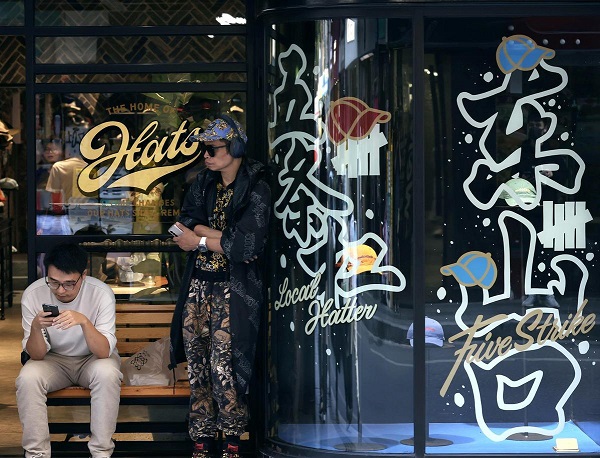
Shoppers pause outside a hat shop in Dongshankou. By employing a "dynamic preservation and organic renewal" revitalization approach, trendy boutiques fit in well with the neighborhood's historical mansions. [Photo by Parker Zheng/chinadaily.com.cn]
Amid a nationwide drive to promote urban development, the affluent residential area in Guangzhou's Yuexiu district has evolved from a delicate balance of "market leads, government facilitates" development approach into a modern commercial zone featuring a cluster of fashion and lifestyle businesses, causing the least damage to its lively neighborhood.
"It's called 'dynamic preservation and organic renewal' that doesn't involve relocating residents," says Wu Yuejun, head of the business promotion unit of the Yuexiu district commerce bureau. "We have made only minor repairs and improvements to some public facilities in certain blocks, relating to signs or damaged road surfaces. The century-old villas remain almost untouched, and the overall appearance of the area, as well as residents' way of life, has not undergone significant changes," he says.
The boom in the ancient town's fashion and cultural sector is attributed to the local government's laissez-faire approach to the development of enterprises. Besides supporting emerging industries entering the market and streamlining the approval process, the authorities have refrained from intervening, allowing the development to take its natural course.
"Whatever the markets can handle, we leave it to them. The government's role is to create the most favorable conditions so that private enterprises can operate in a free and reasonable environment, enabling them to develop themselves fully," says Gu Hongyi, a government official of a local residential community.
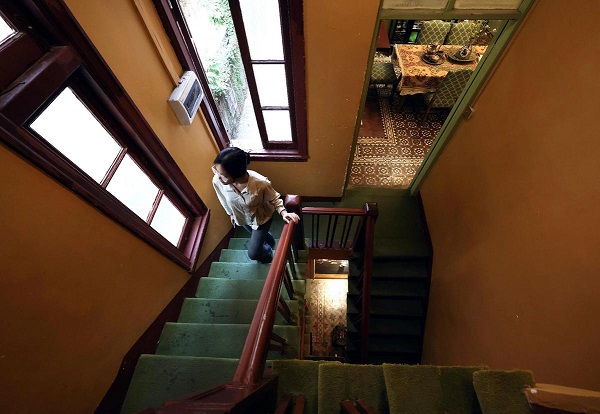
A visitor tours Jue Yuan in Dongshankou. The redbrick villa, with its vintage 20th-century design, was retrofitted in 2017 into an integrated arts venue providing a homestay and exhibition venues. [Photo by Parker Zheng/chinadaily.com.cn]
Historical legacy
But Dongshankou's model is almost impossible to replicate.
The old town elevated its standing as a gathering place for the elite in the 20th century on the heels of investments and property acquisitions by overseas Chinese returning to their homeland. Residents here were the country's most cultivated in those days, with the scions of powerful families living there. They were called "Dongshan Shaoye" (young masters of Dongshan), representing the country's first batch of children from affluent families to receive a Western education and excel in different walks of life.
Today's Dongshankou remains a magnet for the wealthy. Hospitals nearby, such as Guangdong General Hospital, are among the most esteemed in the area. It's also a designated area, with students living there being eligible for admission to the city's most sought-after schools.
It's the high-quality community that has laid a solid foundation for the authorities to thread the needle between businesses and the public. "In terms of management, there are indeed contradictions between different stakeholders with different interests. But, overall, there hasn't been any extremely intense conflict so far," says Wu.
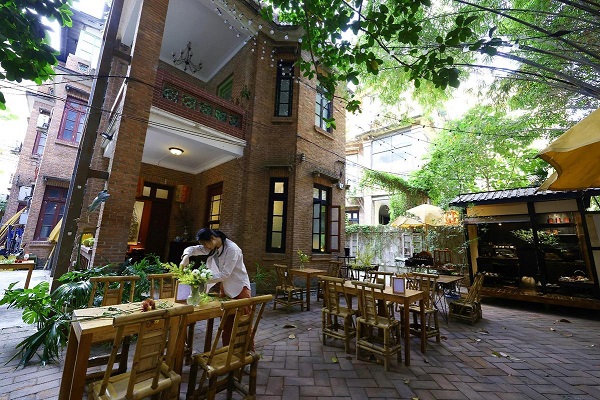
A staff member arranges flowers at Jue Yuan. [Photo by Parker Zheng/chinadaily.com.cn]
He Jingxun, who has lived in Dongshankou for more than seven decades, says a rich historical legacy has endowed the culturally buoyant area with both "elegance" and "innovative thinking", setting it apart from other business streets.
He, dressed in fashion outfits for his interview with China Daily, represents a typical resident of Dongshankou having received a Western education in his early life, enjoying a high standard of living, and with a mindset to embrace new ideas. "Times have changed. But the intrinsic value that defines Dongshankou is still constant," he says. "That's why inclusivity and new developments continue to thrive here."
Yang Jianqiang, a professor and doctoral advisor at the School of Architecture of Southeast University, Nanjing, says the focal point of urban development since the founding of the People's Republic of China has shifted from addressing the basic living conditions and large-scale functional transformation of residential areas to today's people-centeredness and high-quality governance.
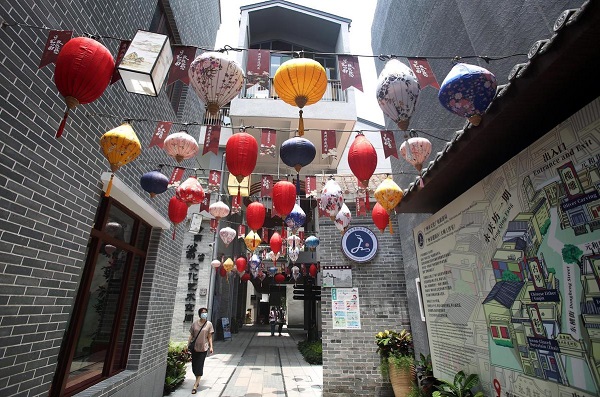
Yongqingfang presents a varied program of exhibitions and activities, offering visitors an opportunity to experience the traditional culture of Guangzhou. [Photo by Parker Zheng/chinadaily.com.cn]
In a paper reviewing the country's urbanization since 1949, he says old town renewal has played a crucial role in improving urban functions and enhancing people's well-being. But how to make the work "more scientific, normalized, systematic and institutionalized" poses unprecedented challenges to urban planning.
Li Lingxi, who had previously worked at a real-estate company, went to Dongshankou from Sichuan province seven years ago. She and her husband rented a redbrick villa named Jue Yuan, and turned it into an integrated arts place offering homestay and exhibition venues.
With an academic background in urban planning and having been involved in various urban development projects, Li sees Dongshankou as a cradle for entrepreneurship. "I've done research on many places to start a business, including my hometown, Chengdu. But Dongshankou is different from the root," she says.
"It's naturally grown, which means it can accommodate a wide range of cultural forms, whether they are traditional, creative or fashionable."
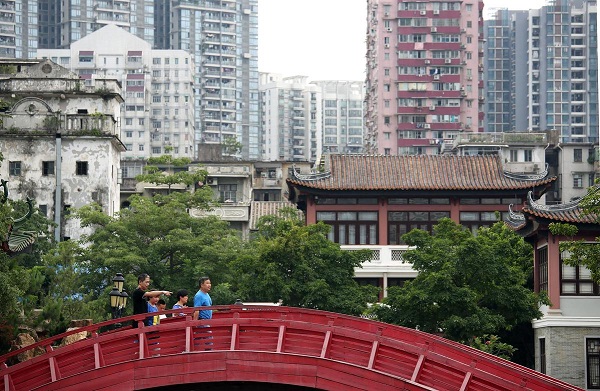
Visitors explore Yongqingfang, a neighborhood repositioned as a cultural and historical area as part of Guangzhou's efforts to renovate its old quarters. [Photo by Parker Zheng/chinadaily.com.cn]
'Urban living room'
Yongqingfang, or "alleyways of eternal celebrations" - an old town situated in Guangzhou's Liwan district - is another splendid example of the city's rejuvenation drive, similarly born out of the joint efforts of government, businesses and local residents. But its trajectory is somewhat different.
It's a key part of a campaign launched by the Liwan district authorities several years ago to reinvigorate the Enning Road - a culturally rich neighborhood previously filled with aging public infrastructure and an underdeveloped living environment. Mainland real-estate giant Vanke acts as the principal investor and operator responsible for implementing and managing the development of Yongqingfang.
Like Dongshankou, the renovation program was carried out under the same concept of "microrehabilitation". Many old buildings have been refurbished, yet still retain their original architectural style and historic value.
But the impact on the local vibe is much more notable as the neighborhood has been transformed from a residential community into a meticulously designed attraction showcasing traditional culture while catering to the needs of tourists.

Yongqingfang also serves as a popular photo spot. [Photo by Parker Zheng/chinadaily.com.cn]
The area, which abounds with boutique shops and cafes, is hugely popular even on weekdays. Some must-see spots, such as the home of Lee Hoi-chuen - the father of late kung fu superstar Bruce Lee - and a Cantonese opera theater attract a large number of visitors daily.
However, the uniqueness of Yongqingfang can be attributed to its equilibrium between business objectives and its determination to protect its culture.
"It's positioned as a cultural and historical neighborhood, rather than a business project. Its value cannot be only measured by its business indicators," says Yongqingfang's development leader Ye Zhe, citing the area's free public admission and affordable products and services.
For Vanke and the local government, the nonprofit project is "a case of social responsibility", says Ye, adding there are, in fact, many ways to make money. "It's a trade-off. It would be easy to use this venue to hold auto shows or as a market for selling street food, but we have chosen not to."
Instead, the old town has launched an array of cultural events, including live musical entertainment, traditional art exhibitions and holiday-featured night markets.
"We hope Yongqingfang can become Guangzhou's 'urban living room' and a benchmark project in the transformation of historical districts," he says.
If you go:
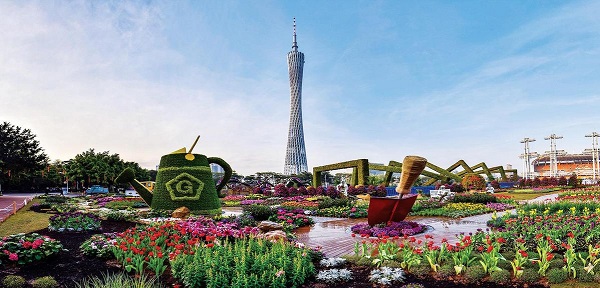
[Photo provided to chinadaily.com.cn]
Canton Tower
Location: Yuejiang West Road, Haizhu district
Highlights: Dubbed the "slim waist", given its twisted shape and hyperboloid structure, the tower is a 600-meter-tall multipurpose observation tower at the intersection of Guangzhou's new urban center and the Pearl River scenic zone. Visitors to the rooftop observatory can enjoy panoramic views of the city.
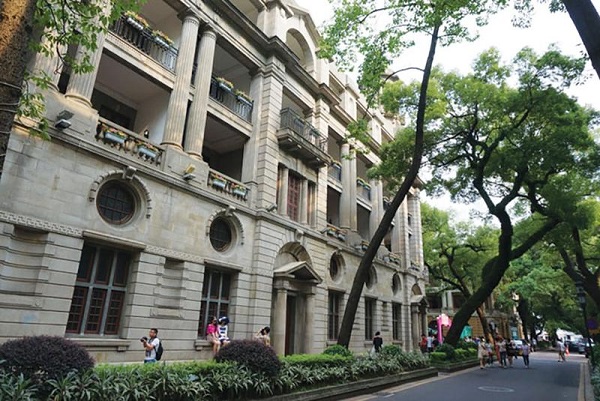
[Photo provided to chinadaily.com.cn]
Shamian Island
Location: Shamian North Street, Liwan district
Highlights: The sandbank island — once an Anglo-French concession, and an important port for Guangzhou's foreign trade — has witnessed many changes in the provincial capital's history. The mansions on the island are some of the best preserved Western European-style buildings in China.
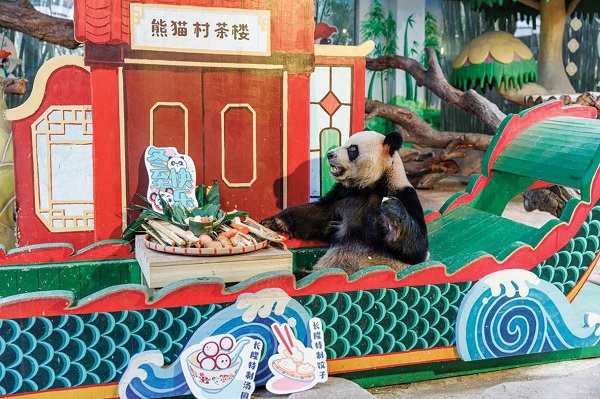
[Photo provided to chinadaily.com.cn]
Chimelong Safari Park
Location: Hanxi Road East, Panyu district
Highlights: Sprawling over 133 hectares, this is one of the country's largest natural parks and Guangzhou's only national top-rated scenic tourism resort. Visitors can view thousands of animals, including giant pandas.
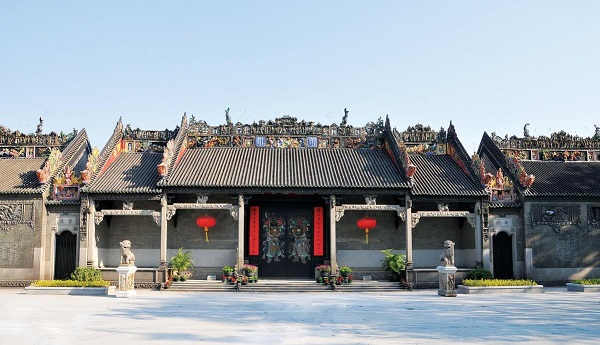
[Photo provided to chinadaily.com.cn]
Chen Clan Ancestral Hall
Location: Zhongshan 7th Road, Liwan district
Highlights: Known as the "pearl of Lingnan architectural art", the hall was built by Chen clan members in 1894 during the Qing Dynasty (1644-1911) for their descendants' accommodation and as somewhere to prepare for imperial examinations. The temple also functions as a museum, exhibiting folk arts and crafts.
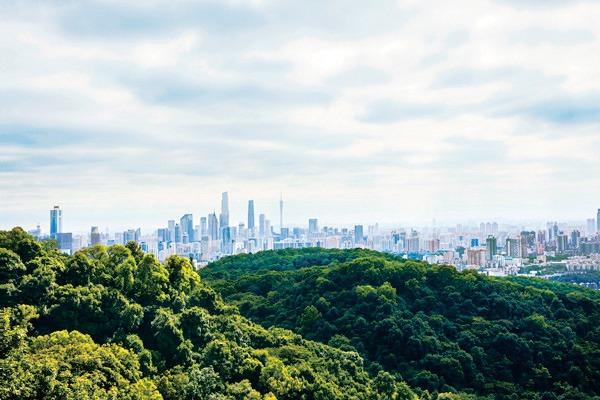
[Photo provided to chinadaily.com.cn]
Baiyun Mountain
Location: Guangyuan Middle Road, Baiyun district
Highlights: This picturesque mountainous region, with more than 30 hills covering an area of 21.80 square kilometers, is Guangzhou's top natural scenic spot. It's rich in overlapping ridges, peaks and freely extending brooks, making it ideal for hiking enthusiasts.
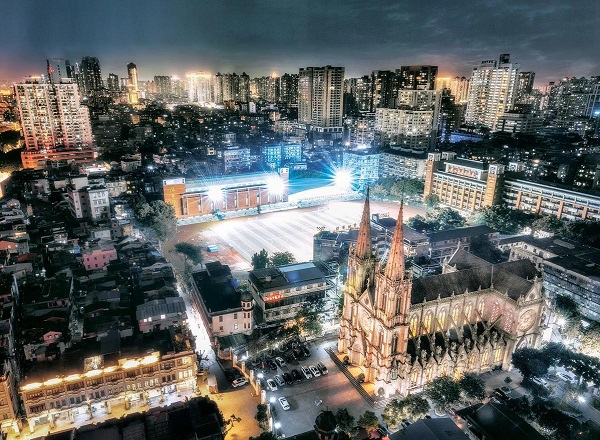
[Photo provided to chinadaily.com.cn]
Sacred Heart Cathedral
Location: Yide Road, Yuexiu district
Highlights: The walls and pillars of the 136-year-old Roman Catholic cathedral are made from granite, and it is regarded as the "Notre Dame of East Asia". It's one of very few all-granite Gothic cathedrals in the world.
Copyright © Foreign Affairs Office of Guangzhou Municipal Government,
Hong Kong and Macao Affairs Office of Guangzhou Municipal Government All rights reserved.
Presented by China Daily.
京ICP备13028878号-28



